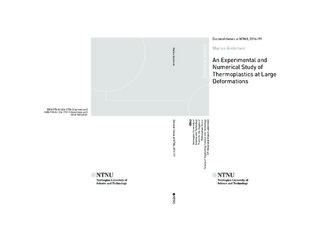| dc.description.abstract | This thesis has examined the mechanical behavior of HDPE and PVC at large strains and at
low to intermediate strain rates. This examination has been done by analyzing experimental
results from uniaxial tension and compressions tests, where the test data has been evaluated
through a combination of improved measurement techniques, simplified 1D material models
and FEM simulations. Strains beyond the natural draw limit of HDPE have been achieved in
uniaxial tension by utilizing a custom-made tension sample.
DIC has been used to measure local deformation of test samples. Extra attention has been paid
to the measurements of local strains as the neck forms and propagates in uniaxial tension. To
this end, a custom implementation of a DIC algorithm has been presented, where the use of
higher order elements has been shown to enable a more precise determination of the location
of the neck. This has facilitated the development of a systematic approach for defining the
section of a sample first experiencing necking and accurately measuring the deformation of
this cross section with an infinitesimal length. An edge tracing algorithm has also been
developed, allowing for the determination of additional geometrical properties of the section
first experiencing necking.
The improved measurement technique has allowed for the precise determination of stress and
strain behavior of both materials at large strains. The measurement and calculation of the
evolution of volumetric strain in uniaxial tension has been a central topic in this thesis, and it
has been shown that a traditional approach to the calculation of volumetric strain can lead to
results that severely misrepresent the actual material behavior. To this end an alternative
equation for calculating the volumetric strain has been proposed and validated. With this
improved method, it has been shown that the polymers investigated in this thesis exhibit a
highly non-linear increase in volume when subjected to uniaxial tension. This volumetric
growth has also been shown to depend on strain rate in the case of HDPE. Adiabatic heating
has also been quantified by the use of a thermal camera, and it has been shown that adiabatic
heating significantly affects mechanical properties even at intermediate strain rates.
The experimental results have been incorporated into a FEM material model. Through
thermo-mechanically coupled simulations, the material model has been shown to accurately capture thermal softening and the non-linear volumetric growth. The simulations have also
revealed discrepancies in the assumption that hardening in polymers is primarily entropic
elastic. This assumption does not appear to be consistent with the measured generated heat
found from experiments, and in the case of PVC it was shown that all hardening had to be
assumed to be dissipative in order to achieve temperatures similar to those measured in the
experiments. | nb_NO |
